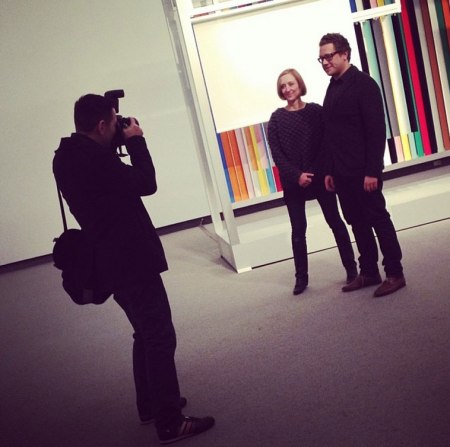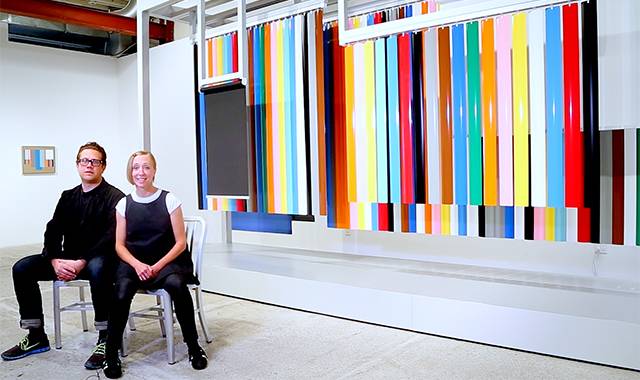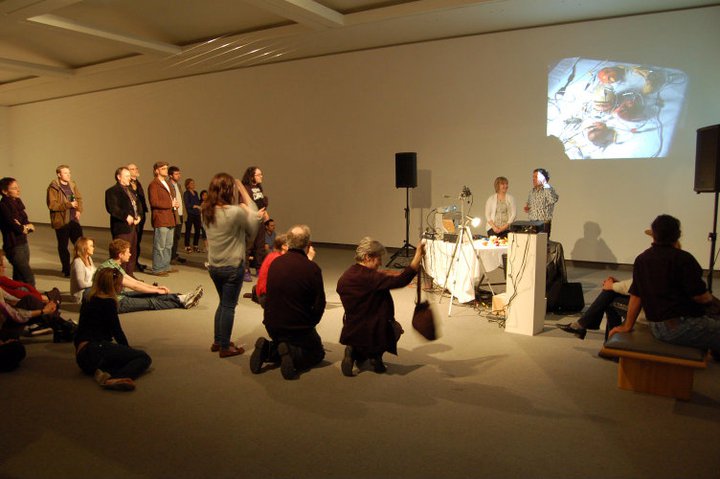LJ: The Collaborationists opened at the Art Gallery of Hamilton in June. How would you compare the final versions of each exhibition?
M & B: The Art Gallery of Hamilton (AGH) exhibition was a broad installation that made use of three distinct and somewhat separate rooms. At AGH, a series of ideas were linked through defined boundaries and thresholds, adjacent to each other, but not necessarily explicitly linked as one unified theme. We were interested in the associations and distance between the works and how the audience would link them. The Collaborationists is not a static exhibition though, it can exist in multiple states. We enjoy the opportunity to present a new form of the exhibition in each of its touring venues. At The Robert McLaughlin Gallery we were inspired by the grandeur of the exhibition space. We responded to this with the decision to install a large-scale singular work. Two editions of Pavilion of the Blind are positioned adjacent to each other to create the largest kinetic sculptural installation that we have produced to date.
LJ: As collaborators, how do you begin work on a concept for a piece? What are your first steps?
M & B: Early in our career it was a longer process, but as we engaged in form, kinetics, technology, and historical reference we began to make more and more connections in our work and so did our audience. Implied here is that we have established a lexicon of precedents that now make our new works easier to rationalize. So for a work like Pavilion of the Blind, we had the precedent of our piece In Sit You, and we had made a remote controlled painting 6 or 7 years ago; we felt that this was the next logical step. How could we make a large-format kinetic work that functioned as painting and sculpture? The nuts and bolts of it are really elemental: what materials to use, how to build, what motors, what computer interface? From there it was a really enjoyable problem solving set of logistics.
LJ: Is there a division of labour in your joint practice? Does one person tend to do more of one thing than another?
M & B: This is a question we are often asked. In all reality some projects are handled by one of us as the lead and the other as the support, and we trade back and forth. In the case of Pavilion of the Blind there were so many suppliers and so many components – we just divided the tasks as best we could. Our collaboration is fluid.
LJ: Your practice deals with social and political issues through the lens of modernism. How does modernism help you engage with the issues that are prominent in your work? And are there particular issues that you will be dealing with in future work?
M & B: There was a sense in 20th century Modernism that we would design a better way of living. Paradoxically there was also a sense that a form of self-conscious individualism could be expressed in visual art. We suppose that in our case, we mine aspects of modernist architecture in Pavilion of the Blind, its positive influences of form and function, but also the off-putting aspects of automation and technocratic societies. So the question is: does the critique come in the form of highly self-conscious expression, or should it be a mirror? And if it is the latter, can it claim the lofty results of high modernism – its claims to presence and weightiness. Suffice to say that we think finding a basis and extrapolating from there is a worthy strategy.For example, there is a current trend in formalism first, in art as vanguard fashion, in some ideas about post-industrial cities and found objects. Maybe we see ourselves as responsive to this. Maybe we see ourselves as an individual style. Maybe this sounds confused? But what we are saying is that there are aspects in our work that attempt to reflexively address our current culture through an analysis of what has also informed it. Modernism is a good place to start. Shamanism, to us, seems like a bit of a stretch.
Visit the Marman & Borins website
LJ: Your work often includes kinetic elements that are instigated by the viewer. Do you find that visitors look at work that they’ve helped to “create” by their presence in the room, differently than static works?
M & B: We definitely have always been a bit skeptical about works of art in general. Should we or anyone trust what an art work is purporting to accomplish? Should we trust what people write or say about an artwork? So this line of thinking informs some early ideas that we had about agency. We were interested in how a viewer controls what is perceived and how an artwork does this. Definitely we think that there is a solid place for interactivity in the art world, its galleries and and museums. Institutions are placing a huge emphasis on interactivity – it is a reflection of our current information culture. And so is Pavilion of the Blind and other works of ours. Yes in this case we definitely imagine our work as connected to the viewer; as completed by the viewer. We like to imagine a viewer watching another viewer view Pavilion of the Blind.
Did you enjoy learning more about these artists? Come to The Collaborationists: A Conversation on Sunday 19 January from 2:30 – 4pm for a lively, engaging, and personal conversation between Jennifer Marman and Daniel Borins, two artists who have been collaborating for over a decade. This is a rare opportunity to sit in on a collegial conversation exploring each artist’s work, process and history. Free to attend.






